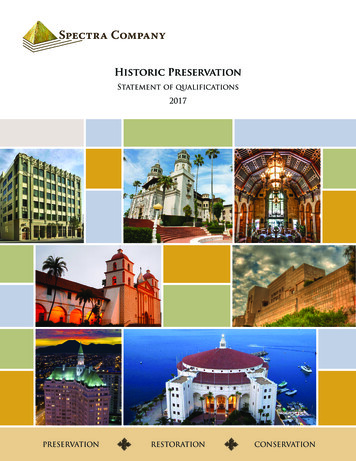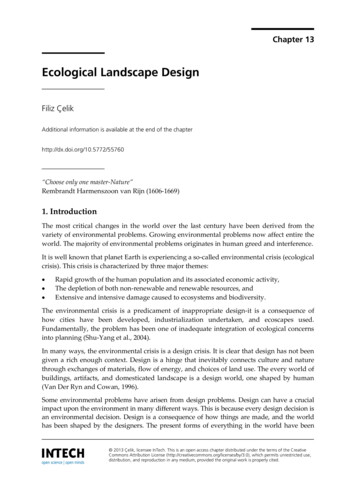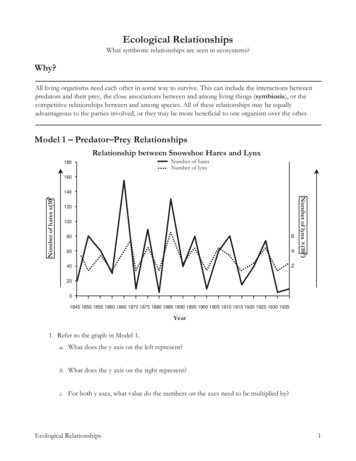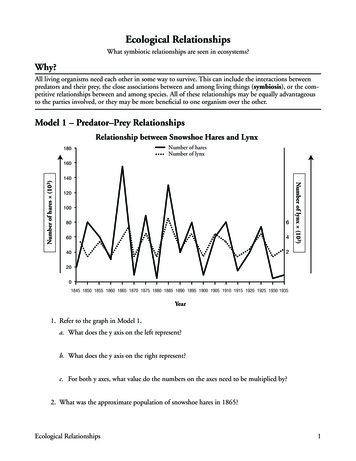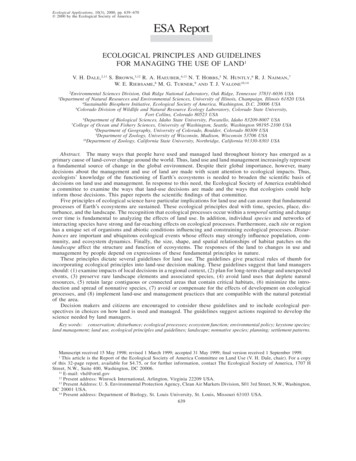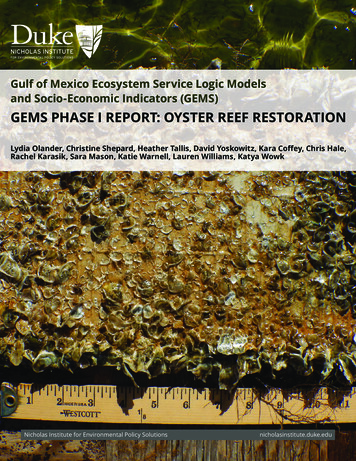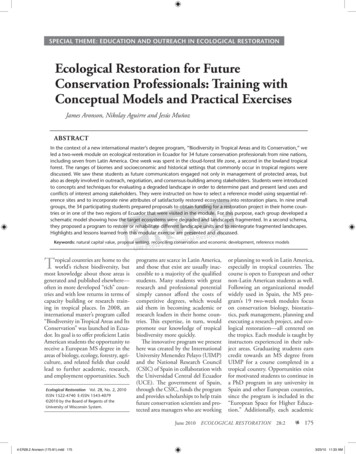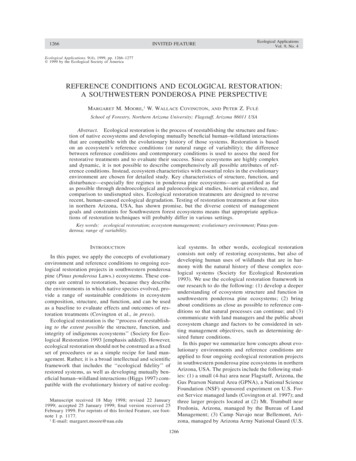
Transcription
1266Ecological ApplicationsVol. 9, No. 4INVITED FEATUREEcological Applications, 9(4), 1999, pp. 1266–1277q 1999 by the Ecological Society of AmericaREFERENCE CONDITIONS AND ECOLOGICAL RESTORATION:A SOUTHWESTERN PONDEROSA PINE PERSPECTIVEMARGARET M. MOORE,1 W. WALLACE COVINGTON,ANDPETER Z. FULÉSchool of Forestry, Northern Arizona University; Flagstaff, Arizona 86011 USAAbstract. Ecological restoration is the process of reestablishing the structure and function of native ecosystems and developing mutually beneficial human–wildland interactionsthat are compatible with the evolutionary history of those systems. Restoration is basedon an ecosystem’s reference conditions (or natural range of variability); the differencebetween reference conditions and contemporary conditions is used to assess the need forrestorative treatments and to evaluate their success. Since ecosystems are highly complexand dynamic, it is not possible to describe comprehensively all possible attributes of reference conditions. Instead, ecosystem characteristics with essential roles in the evolutionaryenvironment are chosen for detailed study. Key characteristics of structure, function, anddisturbance—especially fire regimes in ponderosa pine ecosystems—are quantified as faras possible through dendroecological and paleoecological studies, historical evidence, andcomparison to undisrupted sites. Ecological restoration treatments are designed to reverserecent, human-caused ecological degradation. Testing of restoration treatments at four sitesin northern Arizona, USA, has shown promise, but the diverse context of managementgoals and constraints for Southwestern forest ecosystems means that appropriate applications of restoration techniques will probably differ in various settings.Key words: ecological restoration; ecosystem management; evolutionary environment; Pinus ponderosa; range of variability.INTRODUCTIONIn this paper, we apply the concepts of evolutionaryenvironment and reference conditions to ongoing ecological restoration projects in southwestern ponderosapine (Pinus ponderosa Laws.) ecosystems. These concepts are central to restoration, because they describethe environments in which native species evolved, provide a range of sustainable conditions in ecosystemcomposition, structure, and function, and can be usedas a baseline to evaluate effects and outcomes of restoration treatments (Covington et al., in press).Ecological restoration is the ‘‘process of reestablishing to the extent possible the structure, function, andintegrity of indigenous ecosystems’’ (Society for Ecological Restoration 1993 [emphasis added]). However,ecological restoration should not be construed as a fixedset of procedures or as a simple recipe for land management. Rather, it is a broad intellectual and scientificframework that includes the ‘‘ecological fidelity’’ ofrestored systems, as well as developing mutually beneficial human–wildland interactions (Higgs 1997) compatible with the evolutionary history of native ecologManuscript received 18 May 1998; revised 22 January1999; accepted 25 January 1999; final version received 25February 1999. For reprints of this Invited Feature, see footnote 1 p. 1177.1 E-mail: margaret.moore@nau.eduical systems. In other words, ecological restorationconsists not only of restoring ecosystems, but also ofdeveloping human uses of wildlands that are in harmony with the natural history of these complex ecological systems (Society for Ecological Restoration1993). We use the ecological restoration framework inour research to do the following: (1) develop a deeperunderstanding of ecosystem structure and function insouthwestern ponderosa pine ecosystems; (2) bringabout conditions as close as possible to reference conditions so that natural processes can continue; and (3)communicate with land managers and the public aboutecosystem change and factors to be considered in setting management objectives, such as determining desired future conditions.In this paper we summarize how concepts about evolutionary environments and reference conditions areapplied to four ongoing ecological restoration projectsin southwestern ponderosa pine ecosystems in northernArizona, USA. The projects include the following studies: (1) a small (4-ha) area near Flagstaff, Arizona, theGus Pearson Natural Area (GPNA), a National ScienceFoundation (NSF) sponsored experiment on U.S. Forest Service managed lands (Covington et al. 1997); andthree larger projects located at (2) Mt. Trumbull nearFredonia, Arizona, managed by the Bureau of LandManagement; (3) Camp Navajo near Bellemont, Arizona, managed by Arizona Army National Guard (U.S.1266
November 1999HISTORICAL VARIABILITYDepartment of Defense land); and (4) Grand CanyonNational Park, managed by the National Park Service.We work cooperatively with the federal and state agencies in an adaptive management framework to conductthese larger ecological restoration projects (see Waltersand Holling 1990).Each project is unique, in that the environmentalconditions and the ‘‘players’’ differ slightly at each site,but similar questions and concerns have been raisedregarding restoration of southwestern ponderosa pine:1) What constitutes natural state(s) and processesfor these ecosystems (the evolutionary environmentconcept)?2) What was the role of humans before and afterAnglo-American and Hispanic settlement?3) What are appropriate reference conditions andvariables to measure?4) What is ecological restoration?5) What treatments are best for restoration?We will address each of these questions in relationto pertinent literature and will present our perspective,based on the four northern Arizona projects, on whichecosystem variables are essential to know, and whichare practical to apply in an ecological restoration context, for southwestern ponderosa pine.Southwestern ponderosa pine forests have been thefocus of a wealth of conservation and restoration research. Aldo Leopold recognized the negative effectsof disrupting natural processes in this region (Leopold1924, 1937), initiating his lifelong contributions to theland ethic and the importance of restoring biodiversity.Pearson (1923, 1950) initiated ecological and silvicultural studies; Weaver (1951) pioneered prescribedburning research; Cooper (1960) demonstrated changesin ponderosa pine forest structure due to changing landuse practices; and Dieterich (1980), Swetnam and Baisan (1996), and others applied and refined dendrochronological techniques for reconstructing fire disturbanceregimes. From the establishment of the first Experimental Forest in the U.S. Forest Service (1909, FortValley, Arizona), through continuing involvement ofagency and academic researchers and practitioners,ecological restoration attempts in the Southwest arebased on a broad scientific foundation.THE EVOLUTIONARY ENVIRONMENT CONCEPTThe term evolutionary environment, or evolutionaryhabitat, refers to the environment in which a speciesor groups of species evolved, i.e., the environment (orhabitat) of speciation (Smith 1958, Geist 1978). Overevolutionary time, species not only adapt to their evolutionary environment, but they may also come to depend upon those conditions for their survival (Mayr1942, Mooney 1981, Wilson 1992). Thus, the greatestthreat to biological diversity is the loss of evolutionaryhabitats (Noss and Csuti 1994); habitat restoration offers the greatest hope for reversing this loss (Mac-1267Mahon and Jordan 1994, Dobson et al. 1997). Sinceevolution is an ongoing process, and rates of evolutionare functions of many factors (demography, geneticvariability, and selection pressure, among others), assessing the time scale of the evolutionary environmentrequires an understanding of the paleohistory and ecology of the species involved.Evolutionary environment for ponderosa pinePonderosa pine is the most widespread member ofan ecologically similar group of western long-needledpines in the subsection Ponderosae. These pines shareevolutionary traits, such as protected buds, thick bark,prolific seed production, rapid seedling growth, longresinous needles, highly flammable litter, and longevity, all of which are interpreted as adaptations to frequent, low-intensity surface fires (Mutch 1970, McCune 1988, Barton 1993).The oldest confirmed paleoecological record of thesewestern long-needled pines comes from British Columbia, Canada in the Eocene (55–35 3 106 yr BP) (Axelrod 1986). The evolution and spread of pines duringthe Cenozoic era appears to be related to the development of aridity and seasonal climates, together withperiods of active volcanism and mountain building.These events created new environments and migrationroutes suitable for the stress-adapted pines (Axelrod1986) and created conditions conducive to frequent,surface fires (Pyne 1982).Ponderosa pine (Pinus cf. ponderosa) first appearsin the fossil record in the mid- to late Miocene (17–12 3 106 yr BP) in western Nevada (Axelrod 1986).Ponderosa pine needles from packrat middens, in theSanta Catalina mountains of southern Arizona, datefrom ;14 000 yr BP (Van Devender 1990). Pollen records and macrofossils from northern Arizona suggestappearance in the area ;10 600 yr BP (Anderson 1989).Given the variability in environments over paleoecological times, it is clear that evolution does notoccur at specific points on the surface of the earth.Instead, organisms are quite mobile when viewed onevolutionary time scales. Over the ;50 3 106 yr thatwestern long-needled pine ecosystems have existed,they have presumably moved up and down in elevationand across latitude and longitude, tracking favorableenvironmental conditions.In addition to such long-term influences as climaticchange and mountain building, the evolutionary environment of southwestern ponderosa pine includes important short-term (decades to centuries) disturbanceevents including El Niño–Southern Oscillation,drought, fires, and insect outbreaks (Swetnam and Betancourt 1998). These events vary in kind, frequency,and intensity and often control local population structures (Pickett and White 1985, Covington et al. 1994,Swetnam and Betancourt 1998).
1268INVITED FEATUREWhat was the role of Native Americans?For North America, the recent evolutionary environment generally includes Native Americans as participants during 10 000 yr (Pyne 1982, Parsons et al.1986, Kay 1995, Hunter 1996). Highly structured cultures existed throughout North America, and these people influenced ecosystems through their cultural, hunting, agricultural, and burning practices (Smith 1989,Denevan 1992, Anderson and Moratto 1996).Humans lived in southwestern ponderosa pine ecosystems for millennia prior to the late 1800s, and thisoccupation may have had an appreciable effect on ecosystems in local areas (Hack 1942, Samuels and Betancourt 1982, Altschul and Fairley 1989). At GrandCanyon, for example, there is evidence of long humanoccupancy beginning in Paleoindian times (11 500–9500 yr BP) and declining ;AD 1150–1200 (Altschuland Fairley 1989). More recent evidence of NativeAmerican influence includes the disruption of the localfire regime in the ponderosa pine forests of the ChuskaMountains (northeastern Arizona) ;1830, when sheepgrazing caused a dramatic reduction in the herbaceousmaterial (fine fuels) in the area (Savage 1991).The role of humans in the landscape should not betrivialized, but we also must be cautious not to exaggerate their relative importance in certain locales. Forexample, in contrast to the role of humans as fire starters in the Sierra Nevada (Anderson and Moratto 1996),Swetnam and Baisan (1996) and Swetnam et al. (1999)argue that the natural fire frequency in the forestedareas of the Southwest was high enough that humancaused ignitions would have had a relatively minorimpact, except in special circumstances. Such a specialcircumstance is suggested by Seklecki et al. (1996),where unusual patterns of fire occurrence and seasonality were associated with periods of warfare betweenApaches and Hispanic settlers in southern Arizona.Importance of Anglo-American and HispanicsettlementThe environmental pressures associated with AngloAmerican and Hispanic settlement are relatively recentin comparison to the evolutionary processes of the past10 000 yr or longer. Furthermore, of course, the settlement of the region by Anglo-American and Hispaniccolonists in the Southwest was not simultaneous. Hispanic settlement dates from the 16th century in partsof New Mexico and Arizona, but the ecological effectsof this settlement on upland ecosystems and ponderosapine fire regimes appears to have been limited and localized, perhaps because people lived in compact communities and did not exploit extensive forage resourcesaway from towns (Touchan et al. 1996, Baisan andSwetnam 1997). Several relatively large areas of Arizona and New Mexico highlands (Kaibab Plateau, Mogollon Rim, and Gila Wilderness) were not settled byAnglo-Americans until the late 1800s. Spanish ex-Ecological ApplicationsVol. 9, No. 4plorers passed through northern Arizona in search ofgold, but did not establish settlements; Anglo-American settlement of northern Arizona did not begin untilthe 1860s (Altschul and Fairley 1989). Beginning;1870, industrial-scale resource exploitation, with associated domestic livestock grazing and fire exclusionand suppression, proceeded at a rapid pace throughoutthe Southwest (Cooper 1960). Consequences have included introduction of exotic plants, animals, and landuse practices, as well as the disruption of natural disturbance regimes. These changes are unprecedented inmagnitude in the ponderosa pine type of the Southwestand are viewed as creating new evolutionary trajectories (Covington et al. 1994; see also Dobson et al.[1997] for examples from different regions of the United States).REFERENCE CONDITIONSThe concept of reference conditions (or range of natural variability or historical range of variability) refersto the following: (1) the spectrum and variablility ofnatural conditions in ecosystem composition, structure,and function (Kaufmann et al. 1994, 1998, Swanson etal. 1994); (2) a point of reference against which toevaluate changes in ecosystems (Morgan et al. 1994,Kaufmann et al. 1998); and (3) a criterion for measuring the success of ecological restoration treatmentsand ecosystem management experiments (Christensenet al. 1996).In theory, characterization of reference conditionsshould take any and all ecosystem components intoaccount, including organisms, structures, biogeochemical cycles, disturbance processes, abiotic factors, etc.,and should include the time depth and spatial scales toassure that all influencing factors are considered. Inpractice, however, many of these variables are poorlyunderstood (e.g., mycorrhizal associations) or difficultto measure (e.g., belowground production). Holling(1992) argued that at certain scales, ecological thresholds are controlled by a small group of keystone orhighly interactive organisms and abiotic processes.Keystone variables, in turn, strongly affect their ownenvironment and entrain other structures and processes.Relatively long lists of important ecological variables have been suggested for a variety of ecosystems,such as temperate deciduous forests (Keddy and Drummond 1996) and arid regions (Aronson et al. 1993).Experience and practical constraints have led us to select a subset of keystone variables to reflect the evolutionary environment, as well as for developing a setof reference conditions for southwestern ponderosapine ecosystems.Southwestern ponderosa pineThe evolutionary environment concept is an important guide for identifying key variables of ecosystemstructure and process (i.e., reference conditions) in
November 1999HISTORICAL VARIABILITYsouthwestern ponderosa pine. In general, we use thefollowing procedure to establish a set of baseline (orreference) conditions that are practical to measure ateach of our project sites: (1) determine the key variables; (2) quantify the key disturbance regime(s), especially the historical fire regime; (3) use dendroecological techniques to quantify forest structure and treepattern before and after Anglo-American settlement;(4) use other lines of evidence to confirm forest structure and tree pattern before and after Anglo-Americansettlement; and (5) determine the current and historicalunderstory herbaceous and shrub composition. We feelthat this provides the minimum information needed forany ecological restoration project in this habitat; herewe present the rationale for choosing these.Select key variables.—The essential set of key variables of process and structure we have chosen to measure is relatively small, based on the evolutionary environment of ponderosa pine, and practical to quantify.In the semiarid setting of southwestern ponderosa pineecosystems, the key variables include the predominantcontagious disturbance process, fire, and the autotrophic organisms (trees, shrubs, and herbaceous plants)responsible for microclimate and primary production(Hunter and Price 1992, Fulé et al. 1997). These dominant organisms entrain other communities (fungi, insects, and vertebrates) and indicate ecosystem function(nutrient cycling and productivity). Human activity hasbeen a significant disturbance force since Anglo-American settlement, including livestock grazing, fire suppression, old-growth tree harvesting, and potential impacts from global climate change.Other factors have locally important effects in ponderosa pine ecosystems, but are generally less ubiquitous, including bark beetles, defoliators, parasites,disease, lightning, air pollution, tassel-eared squirrels,and microorganisms. We cannot measure a comprehensive set of variables at all restoration sites, butwhere the project size and resources permit, we havecollaborated on studies to improve understanding ofthe interactions among organisms and processes at avariety of trophic levels (see Covington et al. 1997).Quantify the historical fire regime, the key disturbance process.—Measurement or reconstruction ofpast fire regimes and forest structure in southwesternponderosa pine forests is relatively precise comparedto many other temperate systems because of the dryclimate, slow decomposition rates, and relatively recentimpacts of Anglo-American settlement (;1870 innorthern Arizona) (Covington and Moore 1994a, Swetnam and Baisan 1996, Covington et al. 1997, Swetnamet al. 1999). Dendroecological methods (Fritts andSwetnam 1989, Fulé et al. 1997) can be used to determine fire recurrence within recent evolutionary history, centuries to millennia (e.g., Grissino-Mayer 1995,Swetnam and Baisan 1996, Swetnam et al. 1999). Athorough comparison of southwestern fire history in-1269formation (Swetnam and Baisan 1996) shows the following: (1) southwestern ponderosa pine ecosystemshave experienced high-frequency, low-intensity surface fires for 300–500 yr; (2) low-frequency, highintensity stand replacement fires were very rare or nonexistent; (3) fire frequency fluctuated (with climate)from ;2–20 yr prior to the late 19th century; and (4)a sudden cessation of frequent fire occurred with Anglo-American settlement (1870–1890), due to bothheavy grazing by livestock that removed fine fuels (i.e.,herbaceous material) and active fire suppression practices.The range of variability for pre-Anglo-American settlement (hereafter presettlement) fire frequency atmany of our northern Arizona project areas is less (;2–8 yr using all trees scarred, and 2–15 yr for larger fires)(Fulé et al. 1997; P. Z. Fulé, unpublished data) thanthe regional estimates (2–20 yr) given by Swetnam andBaisan (1996). However, local variability (2–8 yr) compared to the regional variability (2–20 yr) is substantially less than the subsequent ;120-yr period of fireexclusion (Fulé et al. 1997). The key point is, if firerecurrence could be safely restored to a scale measuredin years, rather than centuries, fire would regulate ecosystem structures and processes in a more natural manner in southwestern ponderosa pine than exists today.Quantify forest structure and pattern before and after fire regime disruption.—Trees are dominant structuring organisms in forests. Southwestern forests include ponderosa and pinyon (Pinus edulis) pines, oaks(Quercus spp.), junipers (Juniperus spp.), Douglas-fir(Pseudotsuga menziesii [Mirb.] Franco), and white fir(Abies concolor [Gordon and Glendinning] Lindl.).These trees are interspersed in a matrix of understoryherbaceous and woody plants. In addition to their ecological roles, the long-lived trees and remnant snags,stumps, and logs provide evidence of past vegetationstructure (composition, age, size, density, and spatialpatterns).While forest fire regimes can be determined withrelative precision for the last 400–500 yr in the Southwest, forest structures and evidence of past regeneration dynamics can be reconstructed, at least to the timeof settlement (White 1985), and to some degree evenearlier (Mast et al. 1999). For example, complete reconstruction of living and dead tree age distributionsin 1876, at the the Gus Pearson Natural Area (GPNA)experimental restoration site, shows that tree establishment ranged ;1–4 trees per hectare per decade overthe 300 yr before 1876 (Mast et al. 1999). This rate isseveral orders of magnitude below the hundreds tothousands of trees per hectare which established following grazing and fire exclusion in the early 20thcentury (Fig. 1A, B) (Cooper 1960, Covington andMoore 1994a, Savage et al. 1996, Covington et al.1997).Past forest structure is often reconstructed to ap-
1270INVITED FEATUREFIG. 1. A 50 3 50 m stem-mapped plot from a typicalnorthern Arizona ponderosa pine project site (Mt. Trumbull).These plots demonstrate (A) reconstructed presettlement forest structure (reference structure) circa 1870; (B) contemporary (1995) forest structure showing live trees only; and(C) density and pattern of the trees after the area had beenthinned in a restoration treatment. The shaded areas are projected crowns of live trees, and the small circled 3 symbolsdenote evidence of presettlement dead trees (stumps, snags,logs, etc.).proximately the time of Anglo-American settlement,because the changes in natural disturbance regimes andforest structure initiated by this period are unprecedented in recent evolutionary history. The period inwhich settlement-related activities began to significantly affect native ecological systems is determinedbased on the sudden cessation in frequent fires (determined from fire scars) and on other lines of evidence(see Reference conditions: southwestern ponderosapine: Multiple lines of evidence). Through fire scardata, we know that a frequent fire regime existed at ourproject sites prior to settlement. Ultimately, we infer,given what we know about the evolutionary environment of western long-needled pines, that a relativelyopen, uneven-aged (or multi-aged) forest structure developed under a frequent, surface fire regime. Ofcourse, the exact species composition, density, and pattern will vary from place to place. For instance, presettlement ponderosa pine tree densities are twice ashigh on coarse-textured soils, compared to fine-textured soils, in northern Arizona (Covington and Moore1994b), and the pattern of the former is more ‘‘grovelike’’ (large areas occupied by continuous, yet ratheropen, tree cover) (M. M. Moore, personal observations), whereas the latter are distinct and smaller groupsof trees (Cooper 1961, White 1985). This variabilityEcological ApplicationsVol. 9, No. 4in tree density and pattern must be reflected in sitespecific ecological restoration treatments.The use of a particular reference year around AngloAmerican settlement (vs. an earlier date) is also verypractical. In the absence of low-intensity surface firesduring the past 120 yr, direct evidence of past foreststructure (snags, stumps, logs, and old-growth trees)still exists today, due to slow decomposition rates (Fuléet al. 1997). If we used an earlier date (for instance,1780) as our reconstruction year, then much of the presettlement-era wood evidence would have been consumed by the frequent fires and lost. In other words,structure at the time of settlement is the latest and bestestimate of forest structure consistent with the evolutionary environment for a particular site within ourstudy areas. However, this practice of choosing a specific reference year is sometimes misinterpreted as aview of static or ‘‘equilibrium’’ ecosystems or somefixed ecosystem structure over time (Shinneman andBaker 1997). This is not the case; ecosystems changeover time and continue to evolve. Our approach, comparing predisruptive (presettlement) vegetation conditions to postdisruptive (postsettlement) ones (Leopold 1941, McIntosh 1985, Foster et al. 1990) at acrucial reference year, is simply a reasonable and ecologically sound way to help the land manager visualizeand describe what the forest structure looked like priorto fire regime disruption.Multiple lines of evidence.—Comparing the resultsof dendroecological reconstruction of fire regimes andforest structure with other lines of evidence is a basiccomponent of retrospective ecological research (seeFoster et al. 1990, Swetnam et al. 1999). Multiple linesof evidence include historical photographs (Fig. 2; seealso Smith and Arno [1999] and Swetnam et al. [1999]),early forest or land surveys and inventories (Woolsey1911), early historical accounts (Cooper 1960), andresults developed by other researchers in other ecosystems.Currently, we are relocating and measuring permanent stem-mapped plots established in the early 1900sacross several ponderosa pine sites in Arizona and NewMexico (Woolsey 1912, Pearson 1923). The approachof remeasuring historical plots (e.g., Minnich et al.1995) or sampling relatively undisturbed sites wherethe natural fire regime has continued (Madany and West1983, Fulé and Covington 1996) are important methodsfor establishing reference conditions.Determine understory herbaceous and shrub composition.—The understory herbaceous and shrub species in southwestern ponderosa pine ecosystems provide rapid nutrient turnover and a fuel matrix to carryfrequent surface fires. The understory plants also provide the majority of plant biodiversity (75–85 species/ha at GPNA, M. Moore, unpublished data).Dendroecological reconstruction supported by historical data provides powerful quantitative support for
November 1999HISTORICAL VARIABILITY1271FIG. 2. A comparison over time of the Mt. Trumbull, Arizona, restoration site as seen from nearby Mt. Logan. The topsketch is by H. H. Nichols, an artist who accompanied John Wesley Powell to the Arizona Strip during Powell’s secondexpedition to the Grand Canyon in 1870 (Powell 1961). The bottom photograph was taken from the same location circa1994–1995. Note the increased tree density and the reduced herbaceous vegetation in Potato Valley (midground) during theintervening ;125-yr period.understanding changes in tree structure and fire regimes, but these techniques provide only limited reference data for herbaceous production, abundance, anddiversity. Two studies conducted at the GPNA site examine herbaceous plants at different temporal scales.Opal phytolith sampling is being used to investigatethe long-term stability of forest–grass patches over centuries and the relative abundance of certain woody andherbaceous species (Kerns and Moore 1997, Kerns1999), while current biomass production and speciescomposition are measured on an annual basis in thisrestored experimental site (Covington et al. 1997).These measurements support the development of further hypotheses and help researchers set quantitativetargets (or ranges) for the understory component of theecosystem in an ecological restoration context.ECOLOGICAL RESTORATIONOne dictionary definition of ‘‘restore’’ is to put orbring back into a former or original state; repair or
1272INVITED FEATURErenew (Merriam-Webster 1989). The Society for Ecological Restoration (1993) defined ecological restoration as ‘‘the process of reestablishing to the extent possible the structure, function, and integrity of indigenousecosystems and the sustaining habitats that they provide.’’ Definitions of ecological restoration remain thesubject of much discussion (Jordon et al. 1987, Ralston1994, Jackson et al. 1995, Hobbs and Norton 1996,Higgs 1997, McQuillan 1998). One common attributeis the desire to reestablish (as closely as possible) previous characteristics of an ecosystem’s composition,vertical structure, pattern, function, and dynamics (Jordon et al. 1987, Aronson et al. 1993, Hobbs and Norton1996, Dobson et al. 1997, Higgs 1997). Thus, a majorgoal of ecological restoration is the restoration of degraded ecosystems, in order to emulate conditions thatprevailed before disruption of natural structures andprocesses, i.e., environmental conditions that have influenced native communities over recent evolutionarytime. Leopold (1941), Dobson et al. (1997), and othersfurther suggest that we will develop a deeper understanding of how ecosystem components functionthrough the process of restoration.A central premise of ecological restoration is thatrestoration of natural systems to conditions consistentwith their recent evolutionary environments will prevent their further degradation, while simultaneouslyconserving their native plants and animals (Society forEcological Restoration 1993).Practitioners of ecological restoration recognize thata failure to include human interactions with restoredsystems is not only unrealistic, but also undesirable forlong-term sustainability (Higgs 1997). In fact, in caseswhere novel conditions prevent natural system functions, ongoing management may be required to compensate for the altered conditions. In many respectsecological restoration might best be judged by whetherthe techniques used are setting the ecosystem on a trajec
School of Forestry, Northern Arizona University; Flagstaff, Arizona 86011 USA Abstract. Ecological restoration is the process of reestablishing the structure and func-tion of native ecosystems and developing mutually beneficial human-wildland interactions that are compatible with the evolutionary history of those systems. Restoration is based on an ecosystem's reference conditions (or .


